17 May 2009
Gentlemen,
Following my recent testimony before the Energy and Commerce Committee of the House, you kindly directed a question to me via the Committee Clerks -
"Is there any dispute that, as you say, "How much warming will a given proportionate increase of CO2 concentration cause?" is the central question of the climate debate?I apologise that my reply is a little late. I have taken some time consulting scientific experts. No discourtesy either to you personally or to the Committee was intended.
a) "If so, what is it?
b) "If not, why hasn't the scientific community participating in the IPCC caught the matter?"
James Hansen, the director of the NASA Goddard Institute for Space Studies, has recently suggested that the value of the "final-climate-sensitivity parameter" λ (by which a given radiative forcing ΔF is multiplied to yield the consequent equilibrium increase in global mean surface temperature ΔTs = λΔF) is λ ≈ 0.75,
Svante Arrhenius, the Swedish theoretical chemist and Nobel laureate, provided the first respectable quantification of climate sensitivity to a CO2 doubling in a paper of 1906, published in Vol. 1 No. 2 of the Journal of the Royal Nobel Institute, of which the relevant conclusion is reproduced in facsimile and in translation below -
"Likewise, I calculate that a halving or doubling of the CO2 concentration would be equivalent to changes of temperature of - 1.5 K or +1.6 K respectively."Arrhenius, like many more recent commentators on the IPCC's calculations, does not accord the same very high values to temperature feedbacks as does the IPCC itself. Also, the IPCC has chosen the highest value for the Planck parameter that occurs in the mainstream literature, and there are good theoretical reasons for the conclusion that its chosen value is excessive.
Making appropriate adjustments for these apparent exaggerations by the IPCC, I calculate that true climate sensitivity may well be as little as 1.1 K at CO2 doubling.
Furthermore, one must make allowance for the fact that atmospheric CO2 concentration is rising at only half the rate predicted by the IPCC, even though CO2 emissions are rising at the higher end of the IPCC's expectations. This is because, as the IPCC's 2001 report admits, the IPCC is unable to add up the Earth/troposphere "carbon budget" to within a factor of two of the right answer. The hydrosphere and biosphere - perhaps through increased rates of photosynthesis - are taking CO2 out of the atmosphere and "fixing" it faster than the IPCC had expected. Figure 1 illustrates the discrepancy -
CO2 concentration is rising, but well below IPCC predictions
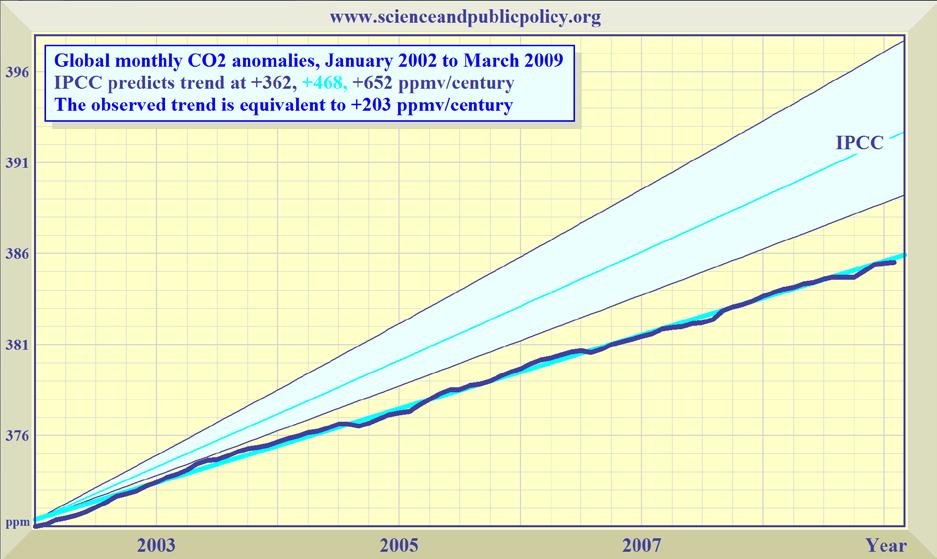
IPCC predicts rapid, exponential CO2 growth that is not occurring
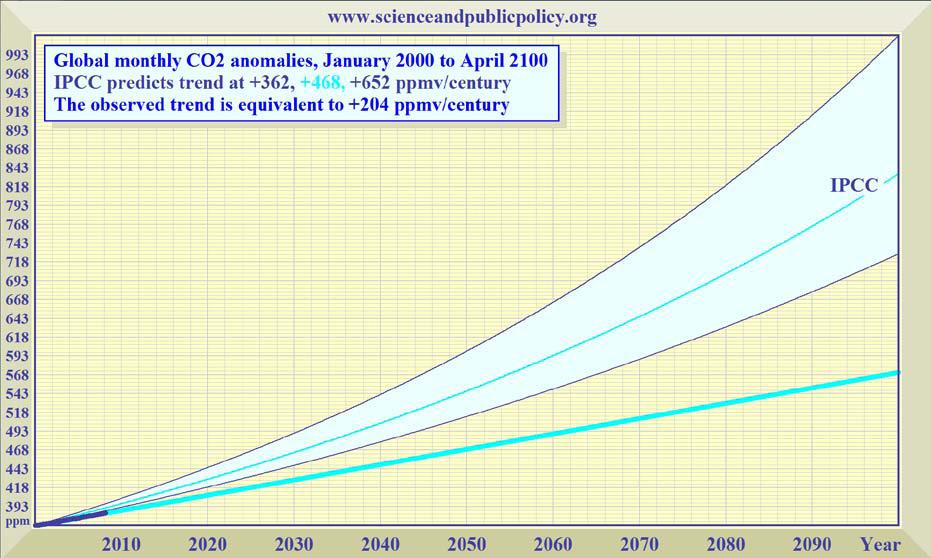
The various changes in climate sensitivity estimates that I have discussed are summarized in Table 1, where successive changes in the parameters whose product is final temperature change are shown in green. The rightmost column shows predicted temperature change to 2100; the penultimate column shows predicted temperature change in response to a doubling of CO2 concentration -
Table 1: Changing climate-sensitivity estimates
As I mentioned in my previous letter to the Committee, there is considerable empirical verification of this theoretically-evaluated result, which has considerable backing in the literature. For instance, direct satellite measurements show that outgoing long-wave radiation has not diminished anything like as fast as the IPCC's climate-sensitivity estimates would require: in fact, as shown in numerous papers, it has diminished at one-seventh to one-tenth of the rate required by the IPCC's climate-sensitivity predictions, implying that climate sensitivity is one-seventh to one-tenth of the IPCC's value.
Further empirical verification is to be found in the now well-established failure of the world's oceans to warm as predicted by the models on which the IPCC relies. Since 2003, some 3300 automated bathythermograph buoys have been deployed throughout the world's oceans in the ARGO program. These buoys have shown no oceanic warming in the five years since they were deployed, contrary to model predictions that pronounced warming would occur. This result is highly significant, because it is the oceans, far more than the atmosphere, that are the real bell-wether of climatic change. The oceans, some 1100
A fourth empirical verification appears in the self-evident failure of the global mean surface temperature record to show any anthropogenic signal whatsoever at any point. The most rapid rate of warming in the 20th century occurred between 1975 and 1978, during which time it is at least theoretically possible that humankind might have had some influence on temperature. However, as I have recently confirmed by arranging for a Parliamentary Question to be put down in the House of Lords, two previous periods - 1860-1880 and 1910-1940 - exhibited precisely the same warming rate, even though the IPCC's own methodology establishes that during those two earlier periods the influence of humankind on temperature was comparatively negligible -
No anthropogenic signal in the global temperature record
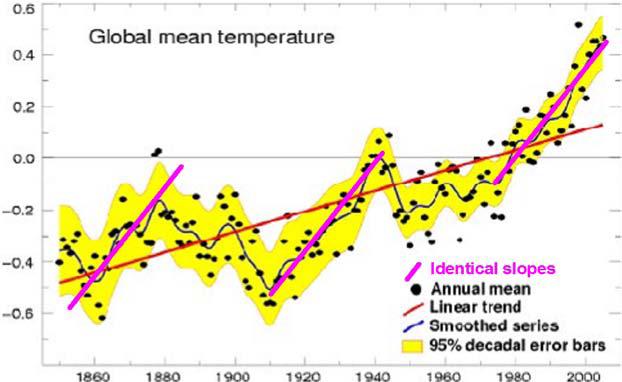
In addition, as Figure 4 shows, since the beginning of the new millennium on 1 January 2001 there has been an eight-and-a-half-year downtrend in global mean surface temperatures, at an equivalent centennial rate rather greater than the uptrend over the 20th century:
A long, unreported downtrend: 8+ years' global cooling at 1 K/century
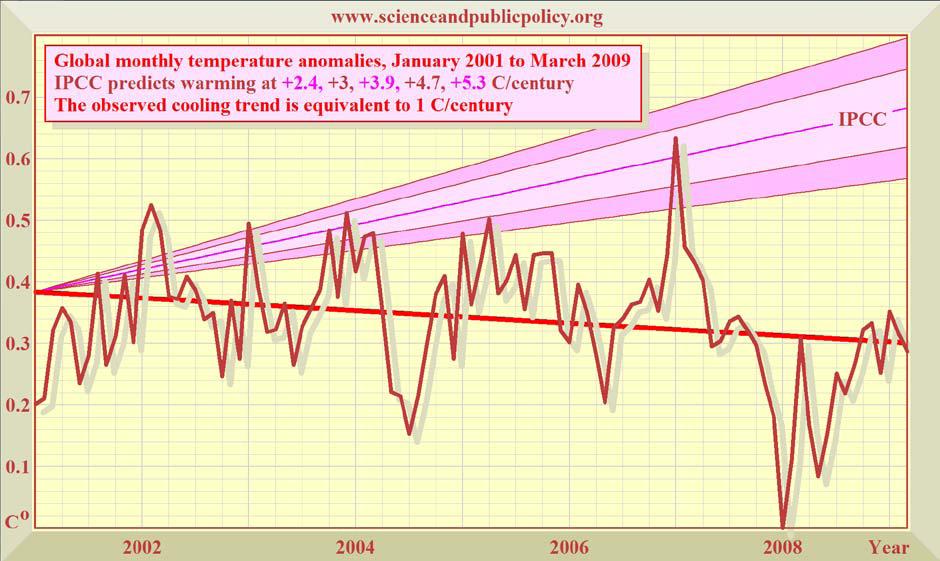
The answer to your subsidiary question b), "Why hasn't the scientific community participating in the IPCC caught the matter?", is simple. Nowhere does the IPCC clearly explain the methodology that it uses in the calculation of climate sensitivity. It leaves scientists to take its climate-sensitivity values upon trust - a trust that, as we have demonstrated, is very likely to be misplaced.
Precisely because the IPCC's methodology is unclear, most scientists do not have the means or opportunity to pick through its lengthy documents in detail and to follow the trail of references in the peer-reviewed literature in order to evaluate for themselves the reliability or unreliability of the IPCC's estimates.
There is plenty of evidence that the majority of the scientists participating in the IPCC's process were not involved in the climate sensitivity calculations: they took those calculations as Gospel and drew conclusions from them - conclusions that in many instances would have been excessive even if the IPCC's climate-sensitivity estimates had not been exaggerated.
The IPCC does not anywhere explain clearly that it calculates greenhouse-enrichment-induced temperature change over time as the product of four parameters, the -
- Radiative forcing, which is the extra energy at the top of the atmosphere caused by atmospheric enrichment with a greenhouse gas such as CO2;
- Planck parameter, which converts the tropopausal radiative forcing to surface temperature change in the absence of temperature feedbacks;
- Temperature-feedback multiplier, which amplifies the initial warming in response to net-positive temperature feedbacks; and
- Natural logarithm of the proportionate increase in CO2 concentration.
However, as I have indicated, the UN has, on average, approximately doubled the value of each of the four parameters. That is, when they are multiplied together, the UN's projection of temperature increase to 2100 becomes approximately 2^4 = 16 times too great. It is this central exaggeration on which all of the UN's overstated conclusions about the impacts of anthropogenic "global warming" absolutely depend.
Yet the vast majority of the scientists who wrote and reviewed the UN's climate reports are unaware of these exaggerations, and most are unaware even that it is the multiplication together of four separate exaggerations that causes the very large overestimates of anthropogenic temperature change over the present century which repeated satellite measurements of changes in outgoing long-wave radiation and bathythermograph measurements of changes in ocean temperature have demonstrated, and without which the UN's entire case for alarm about our effect on the climate falls away.
Some of the crucial parameters are not even explicitly quantified. The question of climate sensitivity ought to be the first question dealt with in each major, quinquennial UN climate assessment: however, the topic is neither explicitly nor completely dealt with either in the 2001 or in the 2007 report.
Often, the values selected by the UN exceed those in the very small number of papers that it cites as justification for the particular values it has chosen. Many papers are cited, but few - if any - provide real justification for the UN's chosen values.
These are some of the reasons why few scientists have noticed the large - and perhaps accidental - exaggeration that has demonstrably resulted from the UN's methodology.
The three other parameters I have mentioned - radiative forcing, the Planck parameter and the feedback factor, which together constitute climate sensitivity - are similarly exaggerated by approximately a factor of two in each instance, as I outlined in my previous letter to the Committee.
Correcting for the UN's exaggerations of each of the four key parameters reduces climate sensitivity from 3.26 C to a small fraction of this value at CO2 doubling, and to a still smaller fraction by 2100.
Whether or not "global warming" will eventually resume, and whether or not it will eventually reach the IPCC's predicted rate (which is at least double any rate that has been observed or inferred since the beginning of the Industrial Revolution, though it would be well below of the rate measured in Central England for the period 1695-1745, before the Industrial Revolution even began, and before humankind could have had even the smallest influence over global temperature), there is one further question which the Committee should of course consider most carefully when marking up the Waxman/Markey Bill.
That question is the cost-effectiveness question. By how much, and at what cost, must anthropogenic CO2 emissions be reduced in order to prevent each 1K (1.8 F°) of imagined future anthropogenic "global warming"?
The cost of each 1K of "global warming" prevented by the Waxman/Markey Bill, even if it were fully implemented, would thus be $60-$600 trillion. It is highly questionable whether the economic costs of simply allowing "global warming" to take its course, even if that "global warming" were to occur on the exaggerated scale imagined by the IPCC, could possibly exceed the monstrous and crippling cost of fully implementing the Waxman/Markey Bill. This cost would fall disproportionately upon the poorest.
I hope that it is clearly understood that I am not making any partisan point here. It is abundantly clear from the attached draft paper that, on any view, the Waxman/Markey Bill is economically and scientifically senseless. Exactly as I had warned the Committee during my testimony, if the Bill were to make any significant impact on global temperature it would be outlandishly and disproportionately expensive, and if the Bill were made inexpensive it could not make any significant impact on global temperature.
The latest draft of the Bill shows that the Majority on the Committee, confronted (by me among others) with the catastrophic consequences for working and low-income families, has decided to opt for a series of pork-barrel opt-outs in an attempt to make the Bill comparatively inexpensive. However, the Bill, even in its much-watered-down form, will still be costly, requiring the creation and maintenance of a series of monstrous, supererogatory and purposeless bureaucracies, which will achieve precisely no reduction in global mean surface temperature but will cost a great deal to run.
If even so complete a shutdown would make no discernible difference to global temperature, then a fortiori the much-diluted measures in the Waxman/Markey Bill, however piously intended, will have no effect whatsoever. From the climatic point of view, the Bill in any form is simply irrelevant, just as any such Bill would be irrelevant, even if it had not been serially attenuated to meet the clamour of various vested-interest groups.
For these reasons, I recommend that, as a matter of urgency, the Committee should now establish a panel of scientists and specialists representing all opinions in the climate debate, so that that panel can examine and report to the Committee upon the objections that I have raised in this and my previous letter to the actions which the Majority now proposes to take.
Let me refer to just one incident. I was asked by Acting Chairman Inslee to give an opinion on ocean acidification, which he and several others among the Majority said they thought was a serious and likely consequence of anthropogenic greenhouse-gas enrichment. I pointed out to the Committee that no global acidification of the oceans has yet been measured, and that corals and other fragile sea-creatures that would certainly disintegrate were pH to fall below 7 had survived atmospheric concentrations of CO2 that were up to 20 times today's levels.
The IPCC's own documents make it explicit that the official theory predicts this outgassing, which is described as the "CO2 feedback". One cannot at the same time argue that "global warming" will make the oceans warmer and that it will increase their acidity (or, rather, reduce their pronounced alkalinity). If many members of the Majority are ill-instructed on fundamental points of this kind, they may find themselves taking decisions that will have catastrophic consequences not only for the families with the lowest incomes but for the US economy as a whole.
I shall be happy to serve on the expert panel that I have recommended, and to bring in experts in relevant fields who will represent the viewpoint which - on the evidence now before me - is very much closer to the truth than that which is represented in the official documents of the IPCC and of the numerous US Government agencies - such as the NRC and the EPA - that are profiting financially and politically by reciting its findings as though they were their own, and that are too readily believed by the Majority, for whatever reason.
I conclude that it would be most unwise - and would achieve no useful climatic objective - to proceed any further with the Waxman/Markey Bill. Long before the Bill really starts to bite, it will have become evident to all but a handful of irredentist zealots that the IPCC has indeed prodigiously exaggerated both the effect of CO2 on global temperature and the rate at which CO2 is accumulating in the atmosphere; that there was not, is not, and will not be any "climate crisis"; and that, even if there were, it would be simpler and cheaper - by orders of magnitude - to have the courage either to do nothing or to adapt as and if necessary than to attempt to mitigate the anthropogenic "global warming" that is imagined by the IPCC but that is not occurring and will not occur.
Even if global mean surface temperature had risen above natural variability, the recent solar Grand Maximum - or merely the natural, internal variability of the climate - may have been chiefly responsible.
Even if the sun were not chiefly to blame for the past half-century's warming, the IPCC has not demonstrated that, since CO2 occupies only one-ten-thousandth part more of the atmosphere that it did in 1750, it has contributed more than a small fraction of the warming.
Even if the fingerprint were present, computer models are long proven to be inherently incapable of providing projections of the future state of the climate that are sound enough for policymaking, because the initial state of the millions of variables that define the climate cannot be measured with sufficient precision reliably to predict future phase-transitions in the chaotic object that is the climate.
Even if per impossibile the models could ever become reliable, the empirical evidence of outgoing long-wave radiation and of ocean temperature trends confirms theoretical evaluations demonstrating that it is not at all likely that the world will warm as much as the IPCC imagines.
Even if the world were to warm that much, the overwhelming majority of the scientific, peer-reviewed literature does not predict that catastrophe would ensue.
Even if mitigation were likely to be effective, it would do more harm than good: already millions face starvation as the dash for biofuels has taken one-third of US agricultural land out of essential food production in just two years: a warning that taking precautions, "just in case", can do untold harm unless there is a sound, scientific basis for them.
Finally, even if mitigation might do more good than harm, adaptation as (and if) necessary would be far more cost-effective than mitigation, and less likely to be harmful.
Yours truly,
VISCOUNT MONCKTON OF BRENCHLEY


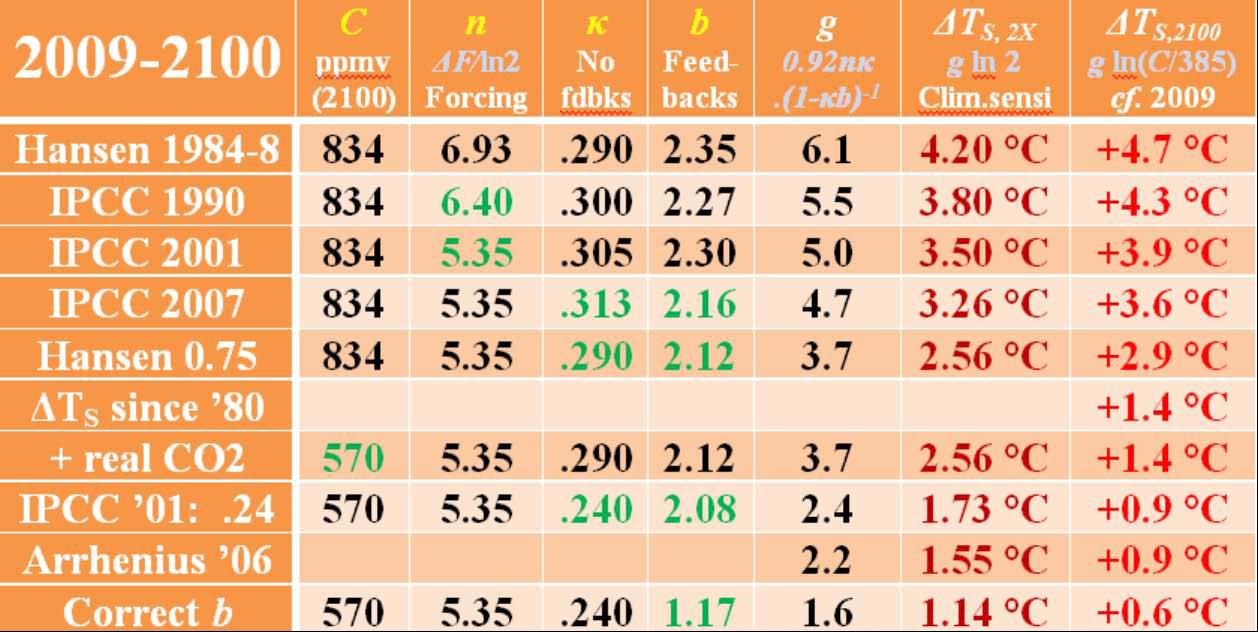




Reader Comments
to our Newsletter